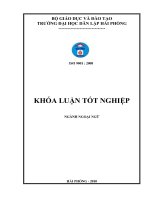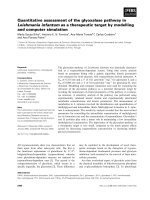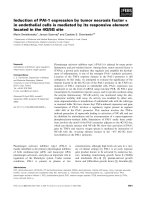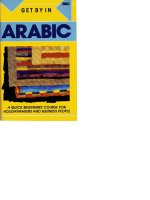Math in focus a Singapore Math by Marshall Cavendish
Bạn đang xem bản rút gọn của tài liệu. Xem và tải ngay bản đầy đủ của tài liệu tại đây (27.25 MB, 311 trang )
!:1
I
I
I
inga
by
re
ath·
Marshall Cavendish
© 2013 Marshall Cavendish International (Singapore) Private Limited
© 2014 Marshall Cavendish Education Pte Ltd
Published by Marshall Cavendish Education
Times Centre, 1 New Industrial Road, Singapore 536196
Customer Service Hotline: (65) 6213 9444
US Office Tel: (1-914) 332 8888 I Fax: (1-914) 332 8882
E-mail:
Website: www.mceducation.com
Distributed by
Houghton Mifflin Harcourt
222 Berkeley Street
Boston, MA 02116
Tel: 617-351-5000
Website: www.hmheducation.com/mathinfocus
Cover: © Stephane Marechal/Photolibrary
First published 2013
All rights reserved. No part of this publication may be reproduced, stored in
a retrieval system or transmitted, in any form or by any means, electronic,
mechanical, photocopying, recording or otherwise, without the prior written
permission of Marshall Cavendish Education. If you have received these
materials as examination copies free of charge, Marshall Cavendish retains
title to the materials and they may not be resold. Resale of examination
copies is strictly prohibited.
Marshall Cavendish and Math in Focus" are registered trademarks of
Times Publishing Limited.
Singapore Math0 is a trademark of Singapore Math Inc. 0 and
Marshall Cavendish Education Pte Ltd.
Math in Focus° Course 1 Student Book A
ISBN 978-0-547-55936-0
Printed in United States of America
13 14 15
4500703012
1401
20 19 18
BCD E
CHAPTER
Positive umbers
~
the
mber Line
Chap'il:eir Opell'lleli' How has the number system changed? . . . . . . . . . . . . . . . . . . . . . .
2
Whole numbers, fractions, and decimals are numbers that can be
represented in several ways.
~li"fl@tl'fif.il'li@Wlle~qaie
°
Finding factors of a whole number
multiples of a whole number
O
Identifying prime numbers
~~11:©i~~
O
°
Finding
Using order of
operations to simplify a numerical expression. . . . . . . . . . . . . . . . . . . . . . . . . . . . . . . . . .
3
The INh.amlber lune . ............................................. .
5
1.1
0
Represent numbers on a number line
O
Write statements of
inequality comparing two whole numbers using the symbols > and <
0
Represent fractions, mixed numbers, and decimals on a horizontal number
line
line
O
O
Represent fractions, mixed numbers, and decimals on a vertical number
Write statements of inequality for two fractions or two decimals using
the symbols > and <
°
Compare numbers in different forms
In Student Book A and Student Book B, look for
0
Practice in every lesson
0
Real-world and mathematical problems in
every chapter
o
at the beginning of every
chapter to assess chapter readiness
0
assess readiness to continue lesson
in every chapter
e
o
Ma.:thJournal exercises
Guided Practice after every Learn to
Chapter Review/Test in every chapter to
review or test chapter material
:-;:.2,1ieHs four times during
the year
1.2
Prime Factorization ............................................ .
16
learn • Identify composite numbers • Write a composite number as a
product of its prime factors
1.3
Common Factors and Multiples . ...............................· ..
19
learn • Identify the common factors of two whole numbers ° Find the
greatest common factor of two whole numbers • Use the greatest common
factor with the distributive property
° Find the common multiples of two
whole numbers • Find the least common multiple of two whole numbers
Hands-On Activity Find the Common Factors and the Greatest Common
Factor of Two Numbers
Squares and Square Roots ..................................... .
Learn • Find a square of a whole number ° Find a square root of a perfect
29
square
Cubes and Cube Roots ......................................... .
learn • Find a cube of a whole number • Find a cube root of a perfect cube
0
33
Evaluate numerical expressions that contain exponents
38
Ch@pterr Wli:'@p l!Jlp • Concept Map • Key Concepts ......................... .
39
Chapierr Re'7iew/Tesi ................................................. .
40
CHAPTER
u
mber
Ch@ptefi' Operrner How cold is an iceberg?. . . . . . . . . . . . . . . . . . . . . . . . . . . . . . . . . . .
42
Negative numbers are the opposites of positive numbers. For every positive
number, there is a corresponding negative number.
0
0
Representing positive numbers on a number line
Writing statements of inequality for two given positive numbers using the
symbols > and < . . . . . . . . . . . . . . . . . . . . . . . . . . . . . . . . . . . . . . . . . . . . . . . . . . . . . . . . .
43
2.1
45
Negative Numbers . ............................................. .
.
0
situations
Recognize the use of positive and negative numbers in real-world
0
Represent negative numbers on a number line
of inequality using the symbols > and <
0
0
Write statements
Interpret and explain statements of
order for positive and negative numbers in real-world situations
Hands-On Activity Represent Negative Numbers on a Number Line and
Compare Two Negative Numbers Using >and<
2.2
Absolute Value . . . . . . . . . . . . . . . . . . . . . . . . . . . . . . . . . . . . . . . . . . . . . . . . . .
.. ·::2,;·:
0
Write the absolute value of a number
0
54
Use absolute value to
interpret real-world situations
58
° Concept Map ° Key Concepts ......................... .
59
CHAPTER
ltiplyi
Ch@pter Opell'ileli" How much do you know about the construction of your home?. . . .
62
Whole number concepts can be extended to fractions and decimals when
more precise calculations are needed.
~ei!:©lU~ !Pirn@r Il\.rril@wied~e e Adding and subtracting decimals e Expressing
improper fractions as mixed numbers e Expressing mixed numbers as improper
fractions e Multiplying fractions by fractions. . . . . . . . . . . . . . . . . . . . . . . . . . . . . . . . . . .
63
Dividing Fractions .............................................. .
65
3.1
Divide a whole number by a unit fraction e Divide a whole number
by a proper fraction e Divide a fraction by a fraction e Divide a fraction by an
improper fraction or a mixed number
e
Hands-On Activities
Dividing Whole Numbers by a Fraction e Dividing
Fractions e Dividing Fractions with a Remainder e Division Involving Whole
Numbers and Fractions
3.2
e
Multiplying Decimals . . . . . . . . . . . . . . . . . . . . . . . . . . . . . . . . . . . . . . . . . . . .
Learn e Multiply tenths by a whole number e Multiply hundredths by a whole
number e Multiply tenths by tenths e Multiply decimals by decimals with one
decimal place e Multiply decimals with one or more decimal places
Hands-On Activity Finding the Factors of a Decimal
78
3.3
Dividing Decimals . . . . . . . . . . . . . . . . . . . . . . . . . . . . . . . . . . . . . . . . . . . . . . .
87
Divide a whole number by a decimal with one decimal place e Divide
a whole number by hundredths O Divide tenths by tenths O Divide hundredths
by hundredths O Divide hundredths by tenths
:,ei'arT
3 •.4
O
Real-World !Problems: Fractions and Decimals . . . . . . . . . . . . . . . . . . . .
94
Multiply decimals to solve real-world problems
Divide decimals
0
to solve real-world problems
Divide a whole number by a fraction to solve
0
two-step problems
Divide a whole number by a fraction to solve multi-step
O
problems
Decide whether to round up or down to solve real-world problems
e Divide a fraction by a whole number to solve real-world problems
e Divide a fraction by a fraction to solve real-world problems
0
O
107
e
Concept Map
e
Key Concepts. . . . . . . . . . . . . . . . . . . . . . . . . .
108
CHAPTER
Chapter Opener How can math help you cook?. . . . . . . . . . . . . . . . . . . . . . . . . . . . . . 114
You can use a ratio to compare two quantities, and you can use ratios to
solve problems.
llte«:11:d; !Pwn@w ll{ll'il@\/'Jledge Expressing fractions as equivalent fractions by
multiplication ° Expressing fractions as equivalent fractions by division
0
Writing equivalent fractions 0 Writing fractions in simplest form ° Converting
0
measurements given in one unit of measure to another 0 Interpreting a comparison
bar model...............................................................
.4.1
Comparing Two Ga.mntities. . . . . . . . . . . . . . . . . . . . . . . . . . . . . . . . . . . . . . .
i"earn ° Understand the meaning of ratio 0 Use a part-part or a part-whole
115
118
model to show ratios • Write and interpret ratios as fractions • Use ratios to
find how many times one number or quantity is as great as another
.4.2
Equivalent Ratios . . . . . . . . . . . . . . . . . . . . . . . . . . . . . . . . . . . . . . . . . . . . . . . .
127
Learn • Equivalent ratios show the same comparisons of numbers and
quantities 0 Use the greatest common factor to write ratios in simplest form
• Equivalent ratios have the same ratio in simplest form ° Find equivalent
ratios by multiplication • Find equivalent ratios by division ° Find the missing
term of a pair of equivalent ratios 0 Work with tables of ratios
.4.3
RealaWorldl Problems: Ratios.....................................
Learn ° Draw models to solve problems involving ratios • Draw models to
140
solve problems involving ratios of three quantities O Draw models to solve
problems involving two sets of ratios • Draw models to solve before-and-after
problems
150
° Concept Map • Key Concepts ......................... . 151
Ch
152
CHAPTER
C!lu::iipterr Ope1nHerr Who is the better goal scorer?. . . . . . . . . . . . . . . . . . . . . . . . . . . . . .
154
You can use a rate to compare one quantity to another quantity, and use
rates to solve problems.
ne,:>,EJ,e
0
Multiplying whole numbers
fractions or mixed numbers by a whole number
0
0
Multiplying
Multiplying fractions
0
Dividing
with fractions and whole numbers
Dividing fractions ° Finding the quantity
represented by a number of units ° Finding ratios ............................. .
155
5.1
159
0
Rates and Unit Rates . . . . . . . . . . . . . . . . . . . . . . . . . . . . . . . . . . . . . . . . . . . .
e
Meaning of rates
a
Express and compute unit rates in terms of time
and other quantities ° Find a unit rate ° Find and compare unit rates ° Find
the speed or rate of travel of a moving object
5.2
168
Real-World Problems: Rates and Unit Rates
o
Solve simple word problems involving rates and unit rates
table to find the information to solve multi-step rate problems
O
O
Read a
Solve multi-
step word problems involving comparison of unit rates ° Find the distance
given the speed and time ° Find the time given the distance and speed ° Find
average speed to solve real-world problems
178
° Concept Map ° Key Concepts ......................... . 179
CHAPTER
Percent
Chapter Openetr How much is a percent?. . . . . . . . . . . . . . . . . . . . . . . . . . . . . . . . . . . 182
~n\gl lclle:©J
Percent is a concept used to compare quantities expressed per hundred.
K®ii:@U~ ~!i'H@!i' Kn@wiedge ° Finding equivalent fractions using multiplication
• Simplifying fractions using division • Writing fractions with a denominator of 100 as
a decimal • Multiplying fractions by a whole number. . . . . . . . . . . . . . . . . . . . . . . . . . . . 183
6.1
Understanding Percent . . . . . . . . . . . . . . . . . . . . . . . . . . . . . . . . . . . . . . . . . .
185
Learn • Meaning of percent • Express a part of whole as a fraction and a
percent • Express percents as fractions or decimals
6.2
Fractions, Decimals, and Percents . . . . . . . . . . . . . . . . . . . . . . . . . . . . . . . .
189
Find the percent represented by a fraction by multiplying by 100%
• Express decimals as percents e Express percents as fractions
!,ean-1 •
Hands-On Activity Expressing Fractions or Mixed Numbers as Percents
6.3
Percent of a Quantity . . . . . . . . . . . . . . . . . . . . . . . . . . . . . . . . . . . . . . . . . . . .
Learn • Find the quantity represented by the percent • Find the whole given
a quantity and its percent
193
6.4
Real World Problems: Percent . . . . . . . . . . . . . . . . . . . . . . . . . . . . . . . . . . .
a
198
Find the percent represented by a quantity
Solve word problems
0
involving taxes
Solve word problems by finding the whole given a quantity
and its percent e Solve word problems involving interest
0
e
6.5
Percent of Change . . . . . . . . . . . . . . . . . . . . . . . . . . . . . . . . . . . . . . . . . . . . . . .
e Solve word problems involving percent increase and decrease
e Solve word problems by finding a quantity represented by a percent ° Find
percent increase or decrease to solve word problems ° Find percent increase
or decrease to solve multi-step problems e Solve word problems involving
fractions and percents
204
214
° Concept Map
e
Key Concepts .......................... 215
«:~u@!PJ,r;;er 1%ewnewluest . . . . . . . . . . . . . . . . . . . . . . . . . . . . . . . . . . . . . . . . . . . . . . . . . . 216
~::ii~
-
CHAPTER
Algebraic Express
a
Chapter Opener How safe is it? . . . . . . . . . . . . . . . . . . . . . . . . . . . . . . . . . . . . . . . . .
218
Algebraic expressions can be used to describe situations and solve
real-world problems
~r/¾([':@ll~ Prra@r K!i'il@VJiedlge 0 Using bar models to show the four operations . . . . . . .
° Finding common factors and greatest common factor of two whole numbers
0
Meaning of mathematical terms
219
1.1
221
Writing Algebraic Expressions . . . . . . . . . . . . . . . . . . . . . . . . . . . . . . . . . .
Learn ° Use variables to represent unknown numbers and write addition
expressions e Use variables to write subtraction expressions O Use variables
to write multiplication expressions O Use variables to write division expressions
7 .2
Evah.aating Algebraic Expressions . . . . . . . . . . . . . . . . . . . . . . . . . . . . . . .
learn ° Algebraic expressions can be evaluated for given values of
226
the variable
1.3
Simplifying Algebraic Expressions. . . . . . . . . . . . . . . . . . . . . . . . . . . . . . .
Learn ° Algebraic expressions can be simplified • Like terms can be added
229
• Like terms can be subtracted O Use order of operations to simplify algebraic
expressions • Collect like terms to simplify algebraic expressions
Hands-On Activity Recognize That Simplified Expressions are Equivalent
1 ..4
Expanding and Factoring Algebraic Expressions . . . . . . . . . . . . . . . . .
Learn ° Use the distributive property to expand algebraic expressions
• Algebraic expressions can be factored by taking out a common factor
Hands-On Activity Recognize That Expanded Expressions Are Equivalent
239
1 a5
Recd World Problems: Algebraic: Expressions . . . . . . . . . . . . . . . . . . . .
Learn ° Write an addition or subtraction algebraic expression for a real-world
0
246
problem and evaluate it • Write a multiplication or division algebraic
expression for a real-world problem and evaluate it
e
Write an algebraic
expression using several operations and evaluate it
252
Ch@~~eir 'J1f5•@p lll~ • Concept Map • Key Concepts ........................ .
253
254
256
Seled:ed Answers . ................................................... .
260
Glossary ............................................................ .
272
icd:»le of Measures, Formu.!!las, and Symbcls ............................ .
276
Credits .............................................................. .
281
Index ............................................................... .
282
Ccmmcn Core State Standards Correlations .......................... .
287
Welcome t o - - - - - - - - - - - - - - - -
What makes
Math in focus® different?
0
Singapore Math
by
Marshall Cavendish
This world-class math program comes to you
from the country of Singapore. We are sure that
you will enjoy learning math with the interesting
lessons you will find in these books.
► Two books
The textbook is divided into
2 semesters. Chapters 1 are in Book A.
Chapters 8-14 are in Book B.
► Longer lessons
More concepts are presented
in a lesson. Some lessons may last more than a
day to give you time to understand the math.
► Bar models and visual models
will help you
make sense of new concepts and solve realworld and mathematical problems with ease.
About the book
Here are the main features in this book.
Chapter Opener
Introduces chapter concepts and big ideas through a story or
example. There is also a chapter table of contents .
. -
Recall Prior Knowledge
",.
,.,
.,
______ __
S'::.-,c.,....,
0 .. ,
o., ..
Assesses previously learned
concepts, definitions, vocabulary,
and models relevant to the chapter.
;;:-,~==~-:---·~ :: ,::::::.:•-:- ·-
___ o-~ ·•-··•··
Quick Check assesses readiness
for the chapter.
xiv
Look for these fecdures i1111 each lesson ..
Like terms can be added.
shows steps that are easy to
follow and understand. It often contains
bar models or other visual models.
Model
mathematics
a)
Simplify 3x
+ x.
3x
X
~
x
I
3x
+X
=X + X + X + X
= 4x
x
I
1·+"X I
I
x
Guided Practice exercises provide
step-by-step guidance through solutions.
Complete.
Simplify x
+ Bx.
x +Bx=_]_
?
X
Cautions alert you to common mistakes
and misconceptions related to the topics.
When adding and subtracting
algebraic terms with no parentheses,
always work from left to right.
For example:
Structure,
reasoning, and
precision
*
7 x - 5x - x 7 x - 4x
9x - 3x + 2x ;,= 9x - 5x
Math Notes are helpful hints
Commutative Property of Addition:
Two numbers can be added in
and reminders.
any order.
So, 4
+a
= a + 4.
xv
Simplify each expression. Then state the coefficient of the variable in each expression.
C)u+u+u+u
0
v+v+S-2
Practke and Math Journal
are included in practice sets.
~.··
c)
Mai:k,jounud Explain how you can use your answers in a) and b) to
show that the following expressions are equivalent.
3x + 6 and 3(x + 2)
Construct viable
arguments
Hands-On Activities and ·
combine logical thinking with
math skills and concepts to help you meet new problem-solving challenges.
Materials:
• paper
ruler
• scissors
Work in pairs.
Make the following set of paper strips.
Let the length of the shortest strip be m units. Make and label 5 such strips.
Hands-On or Technology Activities provide opportunities for investigation,
reinforcement, and extension.
Reason, solve
problems, use
tools and models
Find the perimeter of the figure in terms of x, given that all the angles in the
figure are right angles. If x = 5.5, evaluate this expression.
problems, found at the end of each chapter, are
challenging and promote critical thinking.
xvi
Chapter Wrap Up
Chapter Wrap Up
Key concepts, definitions, and formulas are summarized for
easy review.
The Chapter Wrap Up summaries contain concept maps like
the one shown below.
There may be more than one way to draw a concept map.
With practice, you should be able to draw your own.
Real-life situations
(in word problems)
The center box contains
the big idea for the chapter.
Other boxes represent key
concepts of the chapter.
Numbers
(coefficients)
Variables
are combined
and simplified
to form
can be
Operational signs
Structure,
reasoning, and
precision
+,-,x,+
Evaluated
Factored
Expanded
The lines and arrows show how all the concepts in the
chapter are related to one another and to the big idea.
O·
0
Chapter Review IT est
..
0
...
0
0
.
A practice test is found at the
end of each chapter.
·-~----, --- ·- _., ___
0
C
~
~~-------~--~~,·-
(P•·
·---··.,.
..
o.
Q.
0
O·
Cunnn1,lllative Review
Cumulative review exercises
can be found after Chapters 3,
7, 11, and 14.
··-----·---
c
C •.
•- ..... - - . -.. ., __
~-
..
_, -,
xvii
CHAPTER
The first known use of numbers dates to about 35,000 B.C.E. At that
time, people used tally marks to count things like animals, properties,
and time. Unlike the number system used today, the tally system did
not make use of place value, nor did it use symbols for numbers.
About 5,000 years ago, the Babylonians and the Egyptians began using
number symbols.
The number system that we use today is called the decimal number
system. It makes use ofthe ten numerals 0, 1, 2, 3, 4, 5, 6, 7, 8, and 9.
Using these ten numerals, you can write a number of any magnitude.
It is an efficient and powerful number system that became possible with
the invention of the number 0 and the concept of place value.
finding faders of a whole m.11mber
----------------------
Find the factors of 24.
24
24
=1 X
3
X
24
24
24
8
=2
X
12
4
X
6
The factors of 24 are 1, 2, 3, 4, 6, 8, 12, and 24.
Find the factors of each number.
30
63
56
84
finding ml!Jlltiples of a whole 11n11mber
Find the first six multiples of 7.
1
X
2
X
3
4
5
X
6
=7
7 = 14
7
It is a good idea to write
= 21
the multiples in order
X
7
7
= 28
from least to greatest.
X
7
35
X
7
= 42 ...
7, 14, 21, 28, 35, and 42 are the first six multiples of 7.
Find the first five multiples of each number.
4
6
9
13
Chapter 1 Positive Numbers and the Number Line
3
Identifying prime numbers
A prime number has only two different factors, 1 and the number itself.
Decide whether 11 and 14 are prime numbers.
Find the factors of 11.
Find the factors of 14.
11=1x11
14 = 1
14 = 2
The factors of 11 are 1 and 11.
11 is a prime number.
X
X
14
7
The factors of 14 are 1, 2, 7, and 14.
14 is not a prime number.
~QukkCheck
Complete.
Identify all the prime numbers in the following set of numbers.
2,5, 13,21,23,39,47,51,53,57
Using order of operations to simplify a numerical expression
STEP 1
Work inside parentheses.
STEP 2
Multiply and divide from left to right.
STEP 3
Add and subtract from left to right.
(98
1st expression
+
y
34) - 6
132 - 6
2nd expression
X
y
X
7
7
132 - 42
3rd expression
y
Perform operations in parentheses.
Then multiply.
Then subtract.
90
~ Quick Check
Simplify.
~ (40 - 28) + 8
4
X
7
Chapter 1 Positive Numbers and the Number Line
~ 75
X
(45 -,- 5) - 70
Lesson Objectives
e
VJ@!:11ry
Represent whole numbers, fractions, and decimals on a
number line.
0
number line
whole number
positive number
inequality
Interpret and write statements of inequality for two given
positive numbers using the symbols
>
and
<.
Represent rrnJJmbers on a m.1mber line.
In this chapter, you will learn about various ways of representing numbers.
A number line can be used to represent the set of whole numbers (0, 1, 2, 3, 4, ... ).
0
2
3
4
5
6
7
8
9
A number line can be horizontal or vertical.
On a horizontal number line, the lesser number always lies to the left of the
greater number.
On a vertical number line, the lesser number always lies below the greater number.
9
8
7
6
Positive numbers are all the numbers
greater than 0. On a horizontal number
line, they are to the right of 0. On a
vertical number line, they are above 0.
The set of positive numbers also includes
positive fractions and decimals.
5
4
3
2
0
Collilfi:Bl11ll!Jle 01111 1111elrit IPC!l'£1e
Lesson 1.1 The Number Line
5
a)
Draw a horizontal number line to represent the whole numbers between
5 and 12.
,i:
I
5
6
7
8
9
$
$
I
10
11
12
)I
5 and 12 are not included
because the question asks for
numbers between 5 and 12.
I 1\
b)
Draw a vertical number line to represent the whole numbers from 5 to 12.
12
11
5 and 12 are included
10
because the question asks
for numbers from 5 to 12.
9
8
7
6
5
Write statements of inequality comparing two whole numbers
using the symbols > and <.
You can use a number line to compare whole numbers.
For example, in the number line shown, 35 lies to the right of 33.
30
31
32
33
34
35
So, 35 is greater than 33.
This can be represented by 35 > 33.
6
Chapter 1 Positive Numbers and the Number Line
36
C
Write the statement "110 is less than 250" using > or <.
110 < 250
Use a number line to help
you compare the whole
numbers. Then write the
statement of inequality.
Draw a horizontal number line to represent each set of whole numbers.
Positive whole numbers less than 5
Whole numbers greater than 9 but less than 14
Draw a vertical number line to represent each set of whole numbers.
Odd numbers between 1 and 10
Positive odd numbers < 15
Represent fractions, mixed numbers, cmdl decimals on a horizontal number line.
2)
Represent the fractions
±, !,
and
¾on a number line.
1
s, subdivide each
4
interval between two consecutive
To represent
whole numbers into four equal
intervals using three tick marks.
0
4
2
3
4
4
Lesson 1.1 The Number Line
7









